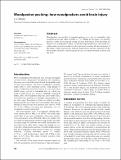Woodpecker pecking: how woodpeckers avoid brain injury
Author(s)
Gibson, Lorna
DownloadGibson-2006-Woodpecker pecking.pdf (246.5Kb)
MIT_AMENDMENT
MIT Amendment
Article is made available in accordance with the publisher's policy and may be subject to US copyright law. Please refer to the publisher's site for terms of use.
Terms of use
Metadata
Show full item recordAbstract
Woodpeckers are capable of repeated pecking on a tree at remarkably high decelerations (on the order of 10 000 m s−2 or 1000 g). In this paper, I re-examine previous studies of pecking and scaling effects in brain injury. I find that there are three keys to woodpeckers' ability to withstand high decelerations: their small size, which reduces the stress on the brain for a given acceleration; the short duration of the impact, which increases the tolerable acceleration; and the orientation of the brain within the skull, which increases the area of contact between the brain and the skull.
Date issued
2006-06Department
Massachusetts Institute of Technology. Department of Materials Science and EngineeringJournal
Journal of Zoology
Publisher
Wiley Blackwell (Blackwell Publishing)
Citation
Gibson, L. J. “Woodpecker Pecking: How Woodpeckers Avoid Brain Injury.” Journal of Zoology 270.3 (2006): 462–465. Web. 20 Apr. 2012. © 2006 The Zoological Society of London
Version: Final published version
ISSN
0952-8369
1469-7998